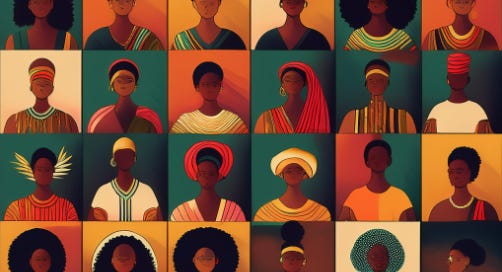Today’s haiku format highlights the number 2.
In numerology, number 2 represents harmony, balance and a strong sense of intuition. Known to some numerologists as a supremely feminine force because it carries both grace and power, the number 2 is cooperative as it aims to bring peace and thoughtful equilibrium to unbalanced situations. At its core, the 2 represents partnerships, wielding power with diplomacy and tact instead of control and authority, resulting in awesome teamwork .
Written in 2-7-2 syllable structure, this haiku is inspired by the 6th principle of Kwanzaa: Kuumba
The number 2 is very sensitive and due to this, out of all the numbers, it has the strongest intuitive nature. This aligns with the principle of Kuumba, simply because intuition is one of the most important resources one needs when it comes to the art of creation. What do I mean when I say this? Well, intuition is our ability to understand something without the need for much reasoning. Your intuition is a part of your instinctual disposition so therefore, it is not something you need to learn. You are born with it. This makes number 2 a perfect conduit for the manifestation of creativity.
On a very deep and subconscious level, this number can pick up on energies that cannot always be seen. Able to sense feelings instinctively and use these understandings to connect with others empathically; number 2 makes a great mediator and guide since it is able to see and understand situations in unbiased and unique ways. This specific lens, if transformed into content, can become the foundations for limitless creative designs. In this way, the number 2 is an element that not only allows one to tap into their intuitive creative thoughts but also can be the purest way possible to learn to pay attention to what makes one happy. The best creatives are those who are happy with what they are creating. To achieve this, one must know who they are, how they work and why they create.
Kuumba, which means creativity, is that which is inspired by the principle of Nia (purpose). It is a commitment to being creative within the context of restoring our people to their greatness while leaving our communities more beautiful and beneficial than the state it was inherited. This principle has both social and spiritual dimensions that are impressively expressed through the literature and culture of ancient Egypt.
In ancient Egypt, also known as ‘Kemet’ in Kemetic language, there was a significant spiritual and ethical commitment to renewing and restoring its great works, the legacy of the ancestors, and the creative energy of its leaders and nation as a whole. This was considered doing Maat, i.e., reaffirming and restoring truth, justice, propriety, harmony, balance, reciprocity and order. Each pharaoh saw his or her reign then, as one of restoration of Maat, i.e., the reaffirmation, reestablishment and renewal of the Good, the Beautiful and the Right*.
Queen Hatshepsut, one of only a few female pharaohs in thousands of years of ancient Egyptian history, says of her reign,
"I have restored that which was in ruins; I have raised up that which was destroyed when the Aamu were in the midst of Kemet, overthrowing that which had been made, as they ruled in ignorance of Ra (God)."*
Considered one of Egypt’s greatest pharaohs—man or woman—Hatshepsut brought great wealth and creative artistry to her land. She sponsored one of Egypt’s most successful trading expeditions, bringing back gold, ebony, and incense from a place called Punt (very likely modern-day Eritrea). She secured her legacy by building structures that still stand today. She added two hundred-foot-tall obelisks at the great temple complex at Karnak, where one is still intact. And she built the mortuary Temple of Deir el Bahri, a structure with several floors of columns in front, where she’d eventually be buried. Queen Hapshetsut, like so many who came before and after her, exemplifies the principle of Kuumba as she showcases what the power of creative restoration can become through thoughtful creative effort.
In conclusion, I think it is fitting to end this thoughtful reflective analysis with words from Dr. Maulana Karenga himself, the man who created Kwanzaa in 1966. Here he shares why Kwanzaa itself is a representation of Creative Restoration.
“It is of value to note here that my creation of Kwanzaa falls within the restorative conception of creativity. For when I say I created Kwanzaa, the term "created" does not imply or mean "made out of nothing," for it is clearly not the case as the Continental African roots of Kwanzaa shows. What one has, then, is rather a creative restoration in the African spirit of cultural restoration and renewal in both the ancient Egyptian and African American sense of the practice. It is, in fact, restoring that which was in ruins or disuse in many parts of Africa, especially among Africans in America, and attempting to make it more beautiful and beneficial than it was before as the principle of Kuumba (Creativity) requires.”*
*Maulana Karenga, "Restoration of the Husia: Revising a Sacred Legacy" in Maulana Karenga and Jacob Carruthers (eds.), Kemet and the African Worldview, Los Angeles: University of Sankore Press, 1986, p. 97.
The Roots
From which we create greatness
Run Deep













Share this post